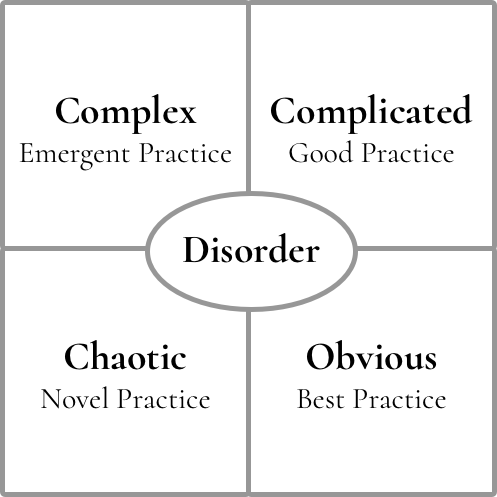How do you make decisions in a crisis?
Do you rely on best practice? Do you experiment?
When do you consult experts? When do you analyze? When do you simply need to act fast?
My work involves helping people think more deeply and make better decisions — for themselves and their companies. Over the last few weeks, my clients have made decisions that affect thousands of people.
The Cynefin framework is a powerful tool to help with decision making. The framework outlines 5 domains: Obvious, Complicated, Complex, Chaotic and Disorder. The goal is to determine which domain you are in and adopt an appropriate decision model.

In the Simple and Complicated domains, events are predictable. In the Complex and Chaotic domains, events are unpredictable. The central space, Disorder is the space of not knowing where you are at all.
An important thing to note is that if you don’t know which domain you are operating in (which is most of the time), you will fall back to a way of operating based on your previous experience, which may not be appropriate for the situation.
Dave Snowden, its creator, describes it as a sense-making model rather than a categorization model, which means it’s used to understand your context better, rather than just simply plotting where you are on a 2x2 grid.
There are plenty of articles that explain the framework in more depth, including this video, so I’d like to focus on a few practical observations.
COVID-19 pandemic is in the Chaotic domain.
“There are no silver bullets here, no easy answers”
What does this mean?
It means that much of what is happening is unpredictable. Best practice doesn’t exist.
This may sounds trite, but even leaders who have a theoretical understanding that the next few weeks are unpredictable are resorting to what has worked before.
Some leaders are experiencing an urge to do something and have implemented:
- Aggressive new routines.
- Commitments that require huge amount of time.
- Large additional administration burdens for themselves and their teams.
The result of a these has been burnout for themselves and churn for their teams.
So what do you do?
The first step is recognizing this domain: Chaotic. Recognizing that how you’ve operated before might not be effective.
The second step is stabilizing. Stabilizing yourself — your own anxiety, your own situation. Do what you need to lead from a stable place. Slowing down.
Then, stabilizing your team and company. It may look like a work from home mandate. This might look like simplifying and not making plans. A few weeks ago for us, it was cancelling an event just so that we had more space to think.
Experiment in the Complex domain
Once the situation is stable, it moves into the Complex domain, where events are still unpredictable, but cause and effect can be seen with hindsight. The key here is to not rush into a plan of action, but be patient and look for patterns.
How do you do this?
By conducting “safe to fail” experiments.
This may look like putting together small task force teams to investigate product options and seeing what sticks. It might be investigating consolidating services to reduce AWS bills. It may be as simple as A / B tests.
The key point is that in a Complex or Chaotic situation, it is a mistake to act without experiment. To resort to process or best practice before you have stabilized the system is unhelpful and in some cases, dangerous.
Acknowledging that you are in unpredictable territory helps
Firstly, it forces you to slow down and admit that you don’t have all the answers. You have to be open to other ideas and experimentation, which encourages innovation.
Secondly, you are forced to confront your decision making impulse. For example, if you’ve been in a bureaucratic environment for a long time, you’ll see most problems as failure of process. If you’re a particular expert, you may see problems as failure to give you enough time to analyze.
And finally, you can go easier on yourself and your team for not having all the answers and not getting everything right.
